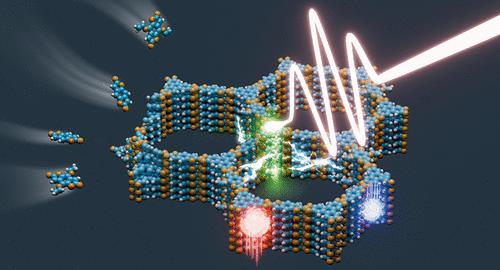当前位置:
X-MOL 学术
›
J. Am. Chem. Soc.
›
论文详情
Our official English website, www.x-mol.net, welcomes your
feedback! (Note: you will need to create a separate account there.)
Photons, Excitons, and Electrons in Covalent Organic Frameworks
Journal of the American Chemical Society ( IF 14.4 ) Pub Date : 2024-11-18 , DOI: 10.1021/jacs.3c14833 Dominic Blätte, Frank Ortmann, Thomas Bein
Journal of the American Chemical Society ( IF 14.4 ) Pub Date : 2024-11-18 , DOI: 10.1021/jacs.3c14833 Dominic Blätte, Frank Ortmann, Thomas Bein

|
Covalent organic frameworks (COFs) are created by the condensation of molecular building blocks and nodes to form two-dimensional (2D) or three-dimensional (3D) crystalline frameworks. The diversity of molecular building blocks with different properties and functionalities and the large number of possible framework topologies open a vast space of possible well-defined porous architectures. Besides more classical applications of porous materials such as molecular absorption, separation, and catalytic conversions, interest in the optoelectronic properties of COFs has recently increased considerably. The electronic properties of both the molecular building blocks and their linkage chemistry can be controlled to tune photon absorption and emission, to create excitons and charge carriers, and to use these charge carriers in different applications such as photocatalysis, luminescence, chemical sensing, and photovoltaics. In this Perspective, we will discuss the relationship between the structural features of COFs and their optoelectronic properties, starting with the building blocks and their chemical connectivity, layer stacking in 2D COFs, control over defects and morphology including thin film synthesis, exploring the theoretical modeling of structural, electronic, and dynamic features of COFs, and discussing recent intriguing applications with a focus on photocatalysis and photoelectrochemistry. We conclude with some remarks about present challenges and future prospects of this powerful architectural paradigm.
中文翻译:

共价有机框架中的光子、激子和电子
共价有机框架 (COF) 是通过分子构建单元和节点的缩合形成二维 (2D) 或三维 (3D) 晶体框架而形成的。具有不同特性和功能的分子构建单元的多样性以及大量可能的框架拓扑结构为可能定义明确的多孔结构开辟了广阔的空间。除了多孔材料的更经典应用(如分子吸收、分离和催化转化)外,最近人们对 COF 的光电特性的兴趣也大大增加。可以控制分子构建单元的电子特性及其键合化学,以调整光子吸收和发射,产生激子和电荷载流子,并将这些电荷载流子用于不同的应用,例如光催化、发光、化学传感和光伏。在这个观点中,我们将讨论 COF 的结构特征与其光电特性之间的关系,从构建块及其化学连接开始,2D COF 中的层堆叠,对缺陷和形态的控制,包括薄膜合成,探索 COF 的结构、电子和动力学特征的理论建模,并讨论最近的有趣应用,重点是光催化和光电化学。最后,我们就这种强大的架构范式的当前挑战和未来前景发表了一些评论。
更新日期:2024-11-19
中文翻译:

共价有机框架中的光子、激子和电子
共价有机框架 (COF) 是通过分子构建单元和节点的缩合形成二维 (2D) 或三维 (3D) 晶体框架而形成的。具有不同特性和功能的分子构建单元的多样性以及大量可能的框架拓扑结构为可能定义明确的多孔结构开辟了广阔的空间。除了多孔材料的更经典应用(如分子吸收、分离和催化转化)外,最近人们对 COF 的光电特性的兴趣也大大增加。可以控制分子构建单元的电子特性及其键合化学,以调整光子吸收和发射,产生激子和电荷载流子,并将这些电荷载流子用于不同的应用,例如光催化、发光、化学传感和光伏。在这个观点中,我们将讨论 COF 的结构特征与其光电特性之间的关系,从构建块及其化学连接开始,2D COF 中的层堆叠,对缺陷和形态的控制,包括薄膜合成,探索 COF 的结构、电子和动力学特征的理论建模,并讨论最近的有趣应用,重点是光催化和光电化学。最后,我们就这种强大的架构范式的当前挑战和未来前景发表了一些评论。


















































 京公网安备 11010802027423号
京公网安备 11010802027423号